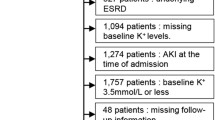Abstract
Background
Hyperkalaemia is a serious adverse effect of unfractionated heparin, but the effect of low-molecular-weight heparins (LMWHs) on potassium levels is not clear. Previous studies have shown a disparity of results depending on the dose and type of LMWH used.
Objective
To analyse potassium level variations in medical and surgical inpatients receiving the LMWH bemiparin sodium at prophylactic doses and assess the consequent effective risk of hyperkalaemia in a real-life setting.
Methods
This was a prospective observational study conducted over a 9-month period in a university teaching hospital. Patients consecutively admitted to internal medicine wards for general medical conditions (n = 145) or to traumatology wards for hip fractures (n = 98) and who received prophylactic bemiparin sodium were enrolled in the study. The intervention consisted of daily dosages of bemiparin sodium (Hibor®) 3500IU (56%)or2500IU (44%) for a minimum of 5 days. The mean age of participants was 80.5 years, with 91.8% being aged ≥65 years. Eighty-six percent of patients had co-morbidities and 79.4% were taking medication affecting potassium homeostasis. The main outcome measures were variations in serum potassium levels observed within 4–8 days of starting bemiparin sodium and the presence of hyperkalaemia (serum potassium >5.1 mmol/L) while on bemiparin sodium treatment.
Results
After patients had received bemiparin sodium for a median 6-day period, the mean (±SD) serum potassium level increased from 4.1 ± 0.5 to 4.3 ± 0.5mmol/L(p < 0.001). Hyperkalaemia >5.1 mmol/L developed in ten patients (4.1%), but serum potassium levels >5.5 mmol/L related to bemiparin sodium were present in only two (0.8%). Laboratory tests between the fourth and eighth days identified all but one case of hyperkalaemia. Patients were not symptomatic and discontinuation of bemiparin sodium treatment was not required. There were no statistically significant differences in potassium disturbances between older (aged ≥65 years) and younger (aged <65 years) patients. The maximum serum potassium level showed a significant inverse correlation with bodyweight (R = −0.731; p = 0.016) and creatinine clearance (R = −0.640; p = 0.046), and a positive correlation with the individual variation in serum potassium levels (R = 0.692; p = 0.027) and with serum potassium levels after 4–8 days on bemiparin sodium treatment (R = 0.741; p = 0.014). Baseline potassium level (odds ratio [OR] 26.5, 95% CI 4.7, 150.3; p < 0.001) and treatment with ACE inhibitors (OR 10.5, 95% CI 1.9, 57.8; p = 0.007) were the only predictors of hyperkalaemia at admission (c-statistic 0.88,95% CI 0.78, 0.99). For patients not receiving ACE inhibitors, a baseline serum potassium >4.6 mmol/L was considered the cut-off value for predicting hyperkalaemia (sensitivity 90% and specificity 70%).
Conclusions
Serum potassium levels in in-hospital traumatology and medical patients increased significantly with bemiparin sodium prophylaxis but the incidence of relevant hyperkalaemia was low. Patients taking bemiparin sodium who are treated with ACE inhibitors or who have a baseline potassium level >4.6 mmol/L should be monitored for serum potassium levels between days 4 and 8 of hospital admission.





Similar content being viewed by others
References
Oster JR, Singer I, Fishman LM. Heparin-induced aldosterone suppression and hyperkalemia. Am J Med 1995 Jun; 98(6): 575–86
Siebels M, Andrassy K, Vecsei P, et al. Dose dependent suppression of mineralocorticoid metabolism by different heparin fractions. Thromb Res 1992 Jun; 66(5): 467–73
Koren-Michowitz M, Avni B, Michowitz Y, et al. Early onset of hyperkalemia in patients treated with low molecular weight heparin: a prospective study. Pharmacoepi-demiol Drug Saf 2004 May; 13(5): 299–302
Canova CR, Fischler MP, Reinhart WH. Effect of low molecular weight heparin on serum potassium. Lancet 1997 May; 349(9063): 1447–8
Potti A, Danielson B, Badreddine R, et al. Potassium homeostasis in patients receiving prophylactic dose en-oxaparin therapy [letter]. J Thromb Haemost 2004 Jul; 2(7): 1208–9
Monreal M, Lafoz E, Salvador R, et al. Adverse effects of three different forms of heparin therapy: thrombocytopenia, increased transaminases, and hyperkalemia. Eur J Clin Pharmacol 1989; 37(4): 415–8
Levesque H, Verdier S, Caileux N, et al. Low molecular weight heparins and hypoaldosteronism. BMJ 1990 Jun; 300(6737): 1437–8
Gheno G, Cinetto L, Savariano C, et al. Variations ofserum potassium level and risk of hyperkalemia in inpatients receiving low-molecular-weight heparin. Eur J Clin Pharmacol 2003 Sep; 59(5–6): 373–7
Martinez-Gonzalez J, Vila L, Rodríguez C. Bemiparin: second-generation, low-molecular-weight heparin for treatment and prophylaxis of venous thromboembolism. Expert Rev Cardiovasc Ther 2008 Jul; 6(6): 793–802
Rocha E, Gómez-Outes A, Martínez Gonzalez J, et al. Effect of unfractionated heparin and long-term treatment with low-molecular-weight heparin, bemiparin, on potassium levels. Thromb Haemost 2005 Nov; 94(5): 1109–10
Charlson ME, Pompei P, Ales KL, et al. A new method of classifying prognostic comorbidity in longitudinal studies: development and validation. J Chronic Dis 1987; 40(5): 373–83
Hosmer DW, Lemeshow S. Assessing the fit of a model. In: Applied logistic regression. 1st ed. New York: John Wiley and Sons, 1989: 140–5
Henz S, Maeder MT, Huber S, et al. Influence of drugs and comorbidity on serum potassium in 15 000 consecutive hospital admissions. Nephrol Dial Transplant 2008 Dec; 23(12): 3939–45
González-Martin G, Díaz-Molinas MS, Martínez AM, et al. Heparin-induced hyperkalemia: a prospective study. Int J Clin Pharmacol Ther Toxicol 1991 Nov; 29(11): 446–50
Durand D, Ader JL, Rey JP, et al. Inducing hyperkalemia by converting enzyme inhibitors and heparin. Kidney Int Suppl 1988 Sep; 25: S196–7
Acknowledgements
This study was supported by a research grant from “Laboratorios Farmacéuticos Rovi”, Madrid, Spain. The funders had no role in study design, data collection and analysis, decision to publish, or preparation of the manuscript. There is no related paper presentation. The authors have no conflicts of interest that are directly relevant to the content of this study. The authors thank Carolyn Newey for editorial assistance.
Author information
Authors and Affiliations
Corresponding author
Rights and permissions
About this article
Cite this article
Torres, O.H., Hernandez, N., Francia, E. et al. Effect of Prophylactic Treatment with Low-Molecular-Weight Heparin Bemiparin Sodium on Serum Potassium Levels. Drugs Aging 27, 399–406 (2010). https://doi.org/10.2165/11535440-000000000-00000
Published:
Issue Date:
DOI: https://doi.org/10.2165/11535440-000000000-00000




